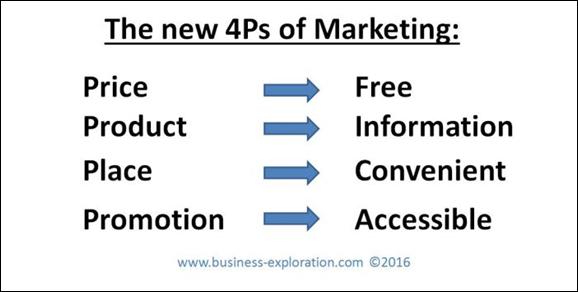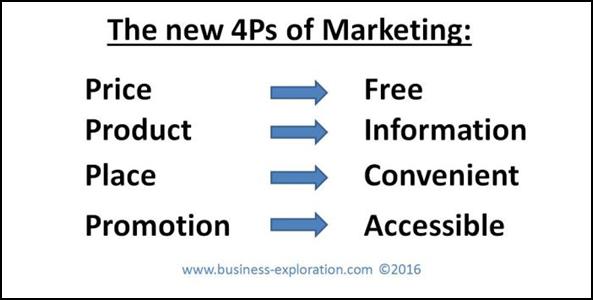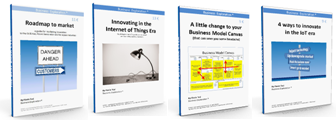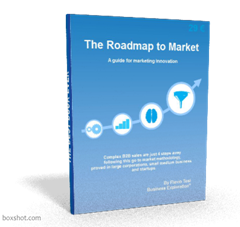If you feel that beating the bush makes no order fly…
it’s because you did not see the 2nd Marketing revolution pass by…
Dear Fellow Innovator,
the Crisis is not the only reason why your orders don’t fly.
We are in a new era of marketing, with new rules never seen before.
The power is now on the Demand side, not on the Supply side.
Yesterday’s organizations were built to cope with scarcity:
Resources were limited, talents were limited, networks were local.
They were built to avoid supply famine: building huge warehouses
of semi-finished goods and “Fort Knox protected” piles of know-how
and rolodex of addresses.
Today’s organizations are flooded with abundance:
Finished goods and services are shipped to them by same-day delivery,
and former rolodex contacts are searched for them by Google.
What happened?
First:
In 1989 the Political Blocks fell down,
In 1993 Europe borders were lifted,
In 2001 China entered the WTO
There are no barriers anymore.
You can get the same stuff everywhere.
(And this has a lot to do with the annoying déjà vu feeling
that grasps us by the throat when we are crossing the fashion windows
of any downtown around the world…)
Second:
In 1993 started the internet revolution (WWW)
In 1995 we got the first browser (Netscape)
In 1999 we got the first world search engine (Yahoo!)
In 2001 two guys give us the answers to any question (Google)
In 2004 a student built the first virtual social network (facebook)
In these same years the degrees of separations
among any two people on the planet passed from 6 to 3:
practically you can tap in anyone, anywhere.
Finally in 2006 the “mobile revolution” made all this possible everywhere, anytime.
Practically we are all living in an era of abundance where everything is here, now.
All this has shifted the Demand/Supply balance to the Demand side.
Buyers look for solutions only when they need it, in a self-serving mode.
What does it mean for us, willing to sell our stuff?
The old rules of marketing do not work anymore:
· You visit 100 Clients and you get zero orders—nada-nothing-niente.
· You spend 1 million “Maria Theresa thalers” in advertising and you get zero leads.
Why?
· Because the chance that you visit your client in the precise moment that he needs you, are close to zero.
· Because people don’t take note of your solution, for a later use, anymore.
And if this could be not fully true on B2C – consumer marketing.
This is dramatically true in B2B – business marketing.
Here, the 2nd Marketing Revolution has caught an entire generation unprepared.
(mine too)
We have been raised to be the greatest toolbox of all the times.
Schools, Universities, Corporations, Business Schools and their “Continuous learning” programs,
have forced as to digest an immense number of tools (and not a single solution):
School programs were stuffed with so much know-how,
that we needed twice the nominal time to complete them:
When I was at university, the average graduation time for a MSc
of Aeronautical Engineering at Politecnico di Milano was 8 years and 9 months.
It took me 6.5 years to graduate and when I crossed the finish line I felt kind of miraculously saved.
The few of my friends that graduated in the regular 5.5 years were regarded as super-hero:
they could compete with the rethoric of Cicero, the memory of Pico della Mirandola and the genius of a Mozart.
But in the words of my Professor Amalia Finzi, I was built as a blank sheet:
something that a Corporation could write over any kind of dream.
And it was exactly like this: I went to Danieli Spa, a steel machinery maker,
and I was able to build a FEM model of a new long product rolling machine in 3 weeks.
This sprang up a discussion with a team of German baby boomer engineers,
until I was able to demonstrate that their design was weak and that we needed a different one.
But I was just young graduated!
The same happened to me in ATOP and in General Electric
where I always solved all kind of difficult problems I was faced.
I was no exception, most of my colleagues did the same.
(after all, we are the ones that built the internet…
not the baby boomers, not the millennials … guess why…;-) )
But today “blank sheet” brains are not useful any longer.
Millions of my colleagues are left home everyday. why?
Because of the 2nd Marketing Revolution.
Today, no company is interested anymore in amassing resources
( in our case: “brains”) for LATER USE.
Today, a company can google: “steel rolling machine” and get all sort and all kinds. NOW.
The same holds true for valves, gas turbines, probes and fittings… and alike.
You “google” it and you get it shipped next day from New Zealand.
Same quality – lower price.
The 2nd Marketing Revolution is commanding to “appear” to the buyer
when he looks for your stuff.
Not before, not later, right then.
……“The only way to achieve this is to assure that you talk to the world about your solution….”
NOOOOOOOOOO!
Wait a moment… do customers search for solution?
NO, they search for problems!
They search for the problem.
They want to understand it, get informed on it and get the needed results – no matter the solution.
Now, look at how we have been built:
· we have been raised to offer a toolbox for later use… and today people want results now.
· we have been told to talk about solutions… and now clients search for problems
· we have been told to be memorable… and now customer rely on Google’s memory.
Do you still wonder why your sales force does not sell a nut?
It’s time that we embrace the 2nd Marketing Revolution too.
· we need to offer Ultraspecific Results to Ultraspecific Problems
· we need to talk about problems and not (only) about solutions
· we need to write it in the silicon memory made of blogs, videos, wikis, mails, podcasts, etc etc and not (only) in the carbon memory of our Clients.
All this is called “Content Marketing” and we have to embrace it.
The First Good News is that we are fully equipped to do it.
We have the power of an immense toolbox.
We only have to start using it in a different way:
stop tracking the sun around the earth but tracking the earth around the sun.
Our fathers (the baby boomers) are no more interested in it, our sons (the Millennials) have always lived like that. We are caught in the middle and have to move out of our hole.
The second Good News is that having all this power, may hurt the buyer too.
It is true that the BUYER HAS THE POWER … BUT:
· his “just in time mentality” means that more than often PRICE is not a real issue… reliability, confidence, convenience are more important.
· his “home delivery” habits means that you can be in contact with him WHEN it has a problem and understand his needs much better.
· his “quest for ultraspecific results” means that you can build a SERVICE universe around him.
· Buyer could theoretically “switch supplier anytime”, but their urgency make risky to implement NOW an unreliable solution.
And I could go on…
And what about the old marketing rules? Are they unuseful?
No: they are more useful than before:
strategizing, segmenting, targeting, building strong positioning, creating:
(P) info that are:
(P) convenient,
(P) accessible,
(P) and free
is of paramount importance.

The old 4P have been just shifted a level up:
from “product” to “information” level,
from “solution” to “problem” level.
and at this level, we, the Mr. Fix, are the one with the best toolbox.
Cordialmente,
Flavio
www.business-exploration.com
————————————————
versione italiana
Se ritieni che scuotere il pero non faccia cadere nessun ordine…
è perché non hai visto passare la 2^ Rivoluzione del Marketing…Caro Collega Innovatore,
La crisi non è l’unica ragione per cui gli ordini non cadono nel cestello. Siamo in una nuova era del marketing, con nuove regole mai viste prima.
Il potere è ora sul lato della domanda, non sul lato dell’offerta.
Le organizzazioni di ieri sono state costruitie per far fronte alla scarsità:
Le risorse erano limitate i talenti erano limitati, le reti sociali erano locali.Erano costruite per egestire la scarsità: con la costruzione di enormi magazzini di semilavorati e mucchi di know-how e elenchi di contatti protetti comela Banca d’Italia.
Oggi le organizzazioni vivono nell’abbondanza:
Beni e servizi vengono spediti finite e consegnati nello stesso giorno,
ed I vecchi contatti vengono ricercati per loro da parte di Google.
Cosa è successo?
Primo:
Nel 1989 i blocchi politici sono caduti,
Nel 1993 sono state abolite le frontiere dell’Europa,
Nel 2001 la Cina è entrata nel WTO
Non ci sono più barriere.
È possibile ottenere la stessa roba ovunque.
(E questo ha molto a che fare con la sensazione fastidiosa di déjà vu che ci prende alla gola quando stiamo passando di fronte alle vetrine di moda di qualsiasi centro cittadino del mondo …)
Secondo:
Nel 1993 è iniziata la rivoluzione di Internet (WWW)
Nel 1995 abbiamo ottenuto il primo browser (Netscape)
Nel 1999 abbiamo ottenuto il primo motore di ricerca del mondo (Yahoo!)
Nel 2001 due ragazzi ci danno le risposte a qualsiasi domanda (Google)
Nel 2004 uno studente costruisce la prima rete sociale virtuale (facebook)
In questi stessi anni i gradi di separazione tra due persone sul pianeta passano da 6 a 3: in pratica si può attingere a chiunque ed ovunque.
Infine, nel 2006 la “rivoluzione mobile” ha reso possibile tutto questo in tutto il mondo, in qualsiasi momento.
Praticamente stiamo tutti vivendo in un’epoca di abbondanza dove tutto è qui, ora.
Tutto questo ha spostato l’equilibrio domanda / offerta sul lato della domanda.
Gli acquirenti cercano soluzioni solo quando ne hanno bisogno, in una modalità self-service.
Che cosa significa per noi, disposti a vendere la nostra roba?
Le vecchie regole del marketing non funzionano più:
· Si visita 100 clienti e si ottiene zero ordini-nada-niente-niente.
· Si spende 1 milione di “talleri di Maria Teresa” nella pubblicità e si ottiene zero richieste.
Perché?
· Perché la possibilità di visitare il cliente nel momento preciso in cui ha bisogno di te, sono vicino a zero.
· Perché le persone non mettono più da parte una soluzione, per un uso successivo.
E se questo potrebbe essere non del tutto vero nel B2C – consumer marketing.
Questo è drammaticamente vero nel B2B – business marketing.
Qui, la 2^ Rivoluzione del Marketing ha colto impreparata un’intera generazione. (anche la mia)
Siamo stati cresciuti per essere la più grande cassetta degli attrezzi di tutti i tempi.
Scuole, Università, Enti, scuole di business e i loro programmi di “formazione continua”, ci hanno costretto a digerire un numero immenso di strumenti (e non una sola soluzione):
I programmi scolastici sono stati farciti con talmente tanto know-how, che ci serviva il doppio del tempo nominale per la loro digestione:
Quando ero all’università, il tempo medio di laurea per un Master di Ingegneria Aeronautica presso il Politecnico di Milano era di 8 anni e 9 mesi.
Mi ci sono voluti 6,5 anni per laurearmi e quando ho passato il traguardo mi sono sentito un miracolato. Quei pochi fra i miei amici che si sono laureati nei regolari 5,5 anni erano visti come super-eroi: potevano competere con la retorica di Cicerone, la memoria di Pico della Mirandola e il genio di Mozart.
Ma nelle parole della mia prof Amalia Finzi, ero stato costruito come un foglio bianco:
una cosa su cui una Grande Azienda avrebbe potuto scrivere qualsiasi tipo di sogno.
Ed è stato proprio così: sono andato in Danieli Spa, un produttore di macchinari per l’acciaio, e sono stato in grado di costruire un modello FEM di una nuova macchina di laminazione in 3 settimane. Questo ha generato una discussione con un team di ingegneri baby boomers tedeschi, fino a quando non sono stato in grado di dimostrare che il loro progetto era debole e che avevamo bisogno di una cosa diversa.
Ma ero solo giovane laureato!
Lo stesso mi è accaduto in ATOP e in General Electric,
dove ho sempre risolto tutti i tipi di difficili problemi che ha dovuto affrontare.
Non ero una eccezione, la maggior parte dei miei colleghi hanno fatto lo stesso.
(Dopo tutto, siamo noi quelli che hanno costruito Internet …
non I figli del baby boom, non I Millennials … indovina perché … ;-))
Ma oggi cervelli tipo “foglio bianco” non servono più.
Milioni di miei colleghi sono lasciati casa ogni giorno. perché?
A causa della seconda rivoluzione del marketing.
Oggi, nessuna azienda è interessata più a accumulare risorse
(nel nostro caso: “cervelli”) per un uso successivo.
Oggi, una società può scrivere in Google: “macchina di laminazione acciaio” e ottenerne di tutte le taglie e di tutti i tipi. ADESSO.
Lo stesso vale per le valvole, turbine a gas, sonde e accessori … e simili.
Lo “googli” e ti arriva il giorno successivo dalla Nuova Zelanda.
Stessa qualità – prezzo più basso.
La 2^ rivoluzione del marketing ci impone di “apparire” al compratore quando cerca per la nostra roba.
Non prima, non dopo, in quel momento.
… … “L’unico modo per raggiungere questo obiettivo è quello di assicurarsi che tutto il mondo conosca la tua soluzione …”.
Noooooooooo!
Aspetta un attimo … I clienti cercano una “soluzione”?
NO, cercano “problemi” !
Cercano il problema.
Vogliono capire, informarsi su di esso e ottenere i risultati voluti – non importa in che modo.
Ora, guardate come ci hanno costruito:
· Ci hanno costruito per offrire una serie di strumenti per un uso successivo … e oggi la gente vuole risultati ora.
· Ci è stato detto di parlare di soluzioni … e ora i clienti cercano per problemi
· Ci è stato detto di essere ricordabili … e ora il cliente affidamento nella memoria di Google.
Ti meravigli ancora perché la forza vendita non vende un bullone?
É tempo che anche noi abbracciamo la 2^ rivoluzione del marketing.
· dobbiamo offrire Risultati Ultraspecifici a problemi Ultraspecifici
· abbiamo bisogno di parlare di problemi e non (solo) di soluzioni
· abbiamo bisogno di scrivere nella memoria di silicio fatta di blog, video, wiki, mail, podcast, ecc ecc e non (solo) nella memoria di carbonio dei nostri Clienti.
Tutto questo si chiama “Content Marketing” e dobbiamo adottarlo.
La prima buona notizia è che siamo completamente attrezzati per farlo.
Abbiamo il potere di una cassetta degli attrezzi immensa.
Dobbiamo solo iniziare ad usarla in un modo diverso:
Smettiamo di tracciare il sole intorno alla terra, e seguiamo la terra attorno al sole.
I nostri padri (i baby boomers) non sono più interessati a questo, i nostri figli (Millennials) hanno sempre vissuto così. Siamo presi in mezzo e dobbiamo uscire allo scoperto.
La seconda buona notizia è che avere tutto questo potere, può danneggiare anche il Cliente.
É vero che il Cliente ha il potere … MA:
· La sua mentalità “just in time” significa che spesso il prezzo non è un vero problema … affidabilità, sicurezza, convenienza sono più importanti.
· la sua predilezione per la “consegna a domicilio” significa che si può essere in contatto con lui quando ha un problema e capire le sue esigenze molto meglio.
· la sua “ricerca di risultati ultraspecifici” significa che è possibile costruire un universo di SERVIZI intorno a lui.
· Il Cliente potrebbe teoricamente “cambiare fornitore in qualsiasi momento”, ma la sua fretta rende rischioso implementare oggi una soluzione inaffidabile.
E potrei continuare …
E per quanto riguarda le vecchie regole di marketing? Non servono più?
No: sono più utili di prima:
Pensare strategicamente, segmentare, il targeting, la costruzione di un forte posizionamento, la creazione di:
(P) Informazioni che siano:
(P) comode,
(P) accessibili,
(P) e gratuite
è di fondamentale importanza.

Le vecchie 4P sono state solo spostate di un livello:
da livello “prodotto” a livello “informazioni”,
da livello “soluzione” al livello “problema”.
e, a questo livello, noi, gli Aggiustatutto, siamo quelli meglio attrezzati.
Cordialmente, Flavio








